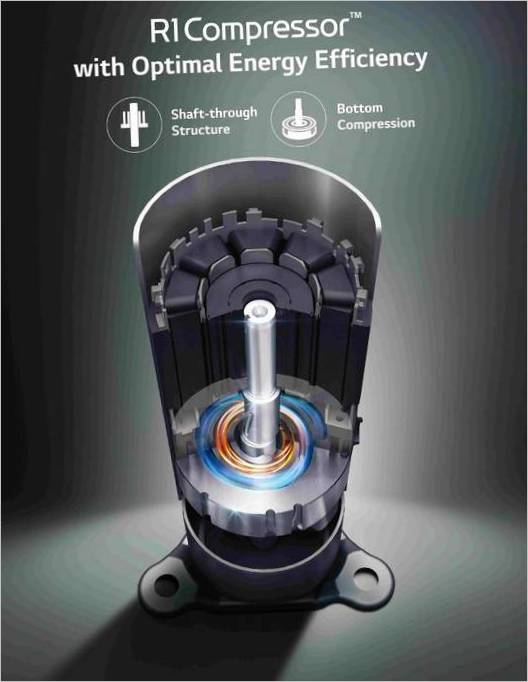One of LG’s leading ventilation, heating and air conditioning developers tells the story of the birth of the LG R1 compressor.

The compressor, which accounts for about 90% of power consumption, plays a crucial role in determining the efficiency and performance of an air conditioner.
–
Please tell us about yourself, your position and your area of responsibility at LG.
My name is Kim Cheol-hwan, I am a developer at L&A Center Air Conditioning Lab, which is part of CTO. We cooperate with LG factory in Changwon and support from conception to commercialization, as a kind of bridge. I joined this team in 2002 and now I’m in charge of research and development for our scroll compressor. This is my second project, the first one was working on a high pressure scroll compressor for the Multi V system.
–
How long does it usually take to finish a project?
It can take seven or eight years from initial planning to mass production. As for the R1 compressor, we began researching the technology in 2010 completed in 2014 , applied for a patent in 2012, began commercialization in 2015, and began launching the product in 2018.
–
Tell us about LG R1 compressor.
Compressors in air conditioners should be highly energy efficient and produce little noise. The LG R1 combines the characteristics of scroll and rotary compressors to meet these two goals.
The shaft must pass through the center of the compression element to ensure optimal oil flow to critical high friction areas. LG developed the world’s first hybrid through-shaft spiral design that not only applied the required pressure even with a through-shaft, but also provided the structural integrity of the spiral shape.
The hybrid scroll consists of twenty differently shaped arcs and compresses the refrigerant in an elliptical shape, thereby avoiding the shaft passing through the center of the compressor. At the end of the compression cycle, the inclination is increased to allow the refrigerant to reach the required pressure faster, and to increase the reliability of the core – more than doubling the thickness of the insulation around the core. LG patented this technology in Korea and the USA.

–
So, the new compressor has combined the advantages of its predecessors scroll and rotary compressor. How did you come up with such an innovative idea?
The development of the R1 compressor began with the idea of maintaining the efficiency of a scroll compressor while using the competitive price of a rotary compressor and its oil supply capacity and simple design.
I like to make a truck analogy to explain how the R1 is better in efficiency than previous compressor models. Whereas in the past people would use a 10-ton truck to carry one ton load, they can now use a one-ton truck for one ton load and a 10-ton truck for a ten-ton load. It seems reasonable to have a compressor that can adjust the capacity according to load conditions. That’s exactly what the R1 compressor does.
LG R1 compressor is the first unit to effectively combine the “compression method” of scroll compressor and the “mechanism design” of rotary compressor while eliminating the disadvantages and imperfections of each type.
–
What were the major design challenges you encountered and how did you overcome them?
- The first challenge: finding the right relationship between gas force and bearing reaction force – positioning the shaft inside the compression element through to solve the fundamental problem of the scroll compressor. However, after placing the shaft in the center of the compression area, we found that there is not enough space for compression and this leads to lower efficiency and reliability. There was also a lack of structural strength. I realized that with the current conventional shape of the spiral it is not possible to place the “shaft through. After discussing possible solutions to the problem with the project team, we came up with a new form of scroll compressor that compresses refrigerant in an ellipse shape during a rotation around the shaft. That’s when one of the best features of the R1 compressor emerged: the world’s first hybrid scroll form with a through-shaft. After that, we started doing in-depth research to make this design a reality.
- The second challenge was that the shaft would bend at high outlet pressures. We came across this when we were trying to understand how to create a scroll compressor with a through-shaft and top compression element. The project was even temporarily suspended because no solution was found. We found ourselves at a crossroads in a situation where our research could have been completely halted. Luckily, LG Electronics has a great support program to help researchers when they are on the brink of failure. This invaluable support allowed us to attract more research funding, and after reorganizing the team, we were able to develop a scroll design with a bottom compression element that was capable of holding the shaft at high outlet pressures.
–
Can you tell us briefly about the main features of the R1 compressor and how they will benefit customers?.
Today we are seeing a trend towards stricter annual energy efficiency standards for air conditioners. So, in order to improve energy efficiency, it is important to reduce energy loss during low-load operation. One of the biggest advantages of R1 compressor is its ability to extend the variable working range to minimize the possibility of energy loss. This allows consumers to save on annual energy costs and enjoy a quieter home environment thanks to the low noise and minimal vibration of the compressor. And its ability to run at high speeds improves heating efficiency at low temperatures.
–
In what products will you use R1 compressor?
We will use the R1 in products ranging from air to water heat pumps AWHPs to refrigeration systems. Air conditioning unit equipped with scroll compressor with bottom compression element can adopt refrigerant injection technology, making it easier to control and adjust the temperature. The strengths of the R1 compressor will stand out in AWHP systems for the key European markets. In Europe, the boiler segment is gradually shifting to AWHP systems under the influence of the general trend towards environmental friendliness and energy efficiency.
The R1 compressor’s ability to operate at a high pressure ratio makes it ideal for refrigeration applications that require temperatures as low as -45˚C. In such cases, usually two scroll compressors connected in series are used. But now only one R1 compressor is needed to do the job.
– What impact will the R1 compressor have on the air conditioning sector and other manufacturing industries?
We will expand the scope of R1 compressor to the entire air conditioning sector. In the future we will try to use our advanced technology in other industries. At this stage, we’re still in the process of learning and looking at future implementations.
– Can you predict what the future of AC market is?
In recent years there has been a growing demand for air conditioning in the HVAC industry due to economic development and rising temperatures in some parts of the world. As a result, energy consumption has increased, and it continues to grow. This increase has played a role in tightening regulations regarding the energy efficiency of air conditioners.
Europe has already tightened its Energy Consumption Products Directive ErP from Class A cooling 5.1/heating 3.4 in 2013 to A+ 5.6/4.0 in 2015, then to A++ 6.1/4.6 in 2017 and to A+++ 8.5/5.1 in 2019.
In order to comply with these standards at all times, we had to develop an environmentally friendly air conditioner that offers high efficiency and uses a low global warming potential GWP refrigerant. We don’t think regulations will be tightened much anytime soon.
However, the new leaders of the HVAC industry will be companies that develop innovative technologies with a focus on efficiency and sustainability.

What were the major factors or reasons that led to the birth of the LG R1 compressor?
What were the key factors and innovations that led to the birth of the LG R1 compressor? Additionally, how does it differ from other compressors in terms of performance and efficiency?